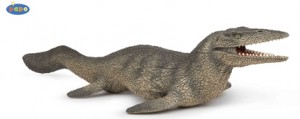Review of the Papo Tylosaurus Replica
“Protuberance Lizard” a new Addition to the Papo Model Range
A replica of the fearsome marine reptile Tylosaurus has been added to the Papo “Les Dinosaures” model range. The umbrella branding – “Les Dinosaures” is proving to be more and more inappropriate for this French manufacturer’s range of prehistoric animal models.
A significant proportion of the models this company now produces are not actually dinosaurs at all. The new Tylosaurus model is an example of this. Tylosaurus was not a dinosaur, in fact although a reptile it and its kind (the mosasaurs) were more closely related to lizards and snakes than they were to the Dinosauria.
Papo Tylosaurus Model
Tylosaurus was formally adopted as the scientific name for a group of large, apex predators of the Late Cretaceous in 1872. Since this is the 140th anniversary of the naming of Tylosaurus, it is pleasing to see Papo introduce a model to commemorate this event. The mosasaurs were a very successful group of marine reptiles. Mosasaur fossils have been found all over the world – in the Americas, Africa, New Zealand, Antarctica and in Europe.
A number of different species of Tylosaurus are now recognised by scientists, Tylosaurus proriger (upon which the Papo model is based), was one of the largest and it hunted in a large inland sea that split North America in two. This seaway is known as the Western Interior Sea.
The Tylosaurus Model (Papo Tylosaurus)
Picture credit: Everything Dinosaur
View Papo Prehistoric Animal Models: Papo “Les Dinosaures” Prehistoric Animal Models.
Tylosaurus Model Measurements
The model itself, measures a little over 24 cm in length, with the skull measuring an impressive 4.5 cm. The largest species of Tylosaurus were up to fourteen metres long, this makes this replica approximately 1:60 scale. Tylosaurus is depicted with its jaws open wide showing an array of sharp, pointed teeth. The tail has a flattened appearance and sports a long, thin frill that runs almost the length of the tail. Scientists believe that Tylosaurus used its powerful, muscular tail to propel itself through the water, using only its four flippers to steer and to change direction.
The Papo model is painted a brown/bronze colour and the texture of the model is quite rough. The scales are clearly marked and the replica, as a result has an almost crocodilian appearance. This contrasts with other mosasaur models from manufacturers which depict these marine lizards as streamlined creatures with smooth-scaled bodies. The available fossil material ascribed to Tylosaurus does not provide palaeontologists with a clear indication of the skin texture of these fearsome reptiles.
It is a robust replica, well suited to creative, imaginative play and as a result, Tylosaurus will probably be equally popular with children as well as professional prehistoric animal model collectors. It is likely that this model will prove to be an asset to the Papo dinosaurs model series, even though it is a marine reptile.


